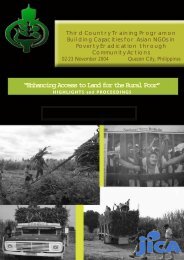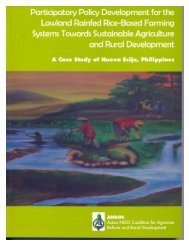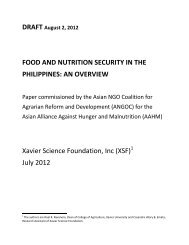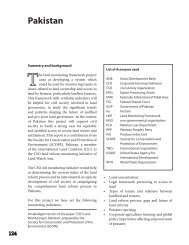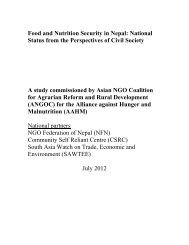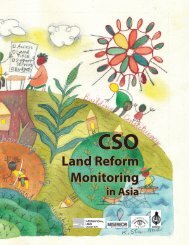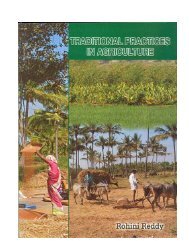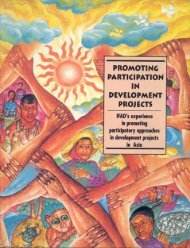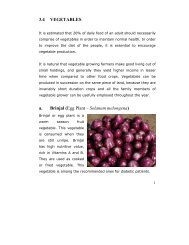Securing the Right to Land FULL - ANGOC
Securing the Right to Land FULL - ANGOC
Securing the Right to Land FULL - ANGOC
Create successful ePaper yourself
Turn your PDF publications into a flip-book with our unique Google optimized e-Paper software.
SECURING THE RIGHT TO LAND136<br />
What is a CADC/CADT?<br />
A Certificate<br />
of Ancestral Domain Claim (CADC) is <strong>the</strong> land<br />
tenure instrument issued by <strong>the</strong> DENR which recognizes <strong>the</strong><br />
claim of indigenous cultural communities <strong>to</strong> land, resources and rights<br />
<strong>the</strong>reon within a defined terri<strong>to</strong>ry. A Certificate of Ancestral Domain<br />
Title (CADT), on <strong>the</strong> o<strong>the</strong>r hand, is a title formally recognizing <strong>the</strong><br />
rights of possession and ownership of Indigenous Cultural Communities/Indigenous<br />
Peoples (ICCs/IPs) over <strong>the</strong>ir ancestral domains that<br />
have been identified and delineated in accordance with <strong>the</strong> Indigenous<br />
Peoples <strong>Right</strong>s Act (IPRA).<br />
The law provides two modes of securing a CADT: direct application<br />
and conversion from CADC <strong>to</strong> CADT. IPs whose ancestral lands/<br />
domains were officially delineated prior <strong>to</strong> <strong>the</strong> enactment of IPRA<br />
have <strong>the</strong> right <strong>to</strong> apply for a CADT over <strong>the</strong> area without going through<br />
<strong>the</strong> mandated process. This, in effect, converts <strong>the</strong>ir CADC <strong>to</strong> CADT.<br />
On <strong>the</strong> o<strong>the</strong>r hand, direct application is <strong>the</strong> process for IP groups<br />
whose ancestral lands were not delineated under any legislation prior<br />
<strong>to</strong> Indigenous Peoples <strong>Right</strong>s Act (IPRA).<br />
The identification, delineation, and recognition of ancestral domains<br />
should be in accordance with <strong>the</strong> procedures outlined in <strong>the</strong><br />
IPRA (Section 52) and its accompanying Implementing Rules and<br />
Regulations (IRRs). However, <strong>the</strong>re is no clear guideline on how long<br />
<strong>the</strong> process should take.<br />
In <strong>the</strong> case of direct applicants, a study by PhilDHRRA found that<br />
<strong>the</strong> average time from <strong>the</strong> start of <strong>the</strong> application process <strong>to</strong> <strong>the</strong> approval<br />
of <strong>the</strong> CADT is 3.4 years. In addition, it will take an average of 6.35<br />
months before <strong>the</strong> issued CADTs are actually awarded <strong>to</strong> <strong>the</strong> tribes.<br />
Free and Prior Informed Consent (FPIC) of <strong>the</strong> IP community–i.e.,<br />
“consensus of all members of <strong>the</strong> IPs/ICCs <strong>to</strong> be<br />
determined in accordance with <strong>the</strong>ir respective cus<strong>to</strong>mary<br />
laws and practices, free from any external manipulation,<br />
interference or coercion” (Chapter 2, Section 3g, IPRA);<br />
IP land rights are recognized through <strong>the</strong> issuance of a<br />
Certificate of Ancestral Domain Claim (CADC) or a Certificate<br />
of Ancestral Domain Title (CADT).<br />
3. R.A. 8550, or <strong>the</strong> Fisheries Code of 1998<br />
Signaled a change in government fisheries policy from a<br />
production and exploitation orientation <strong>to</strong> stewardship and<br />
protection;<br />
Provides for <strong>the</strong> establishment of fisherfolk settlement<br />
areas. However, it does not grant fisherfolk residents security<br />
of land tenure;<br />
Gives jurisdiction <strong>to</strong> <strong>the</strong> municipal or city government<br />
over municipal waters. The agencies involved in carrying<br />
out <strong>the</strong> activities for delineation or delimitation are <strong>the</strong><br />
Department of Agriculture (DA) through <strong>the</strong> Bureau of<br />
Fisheries and Aquatic Resources (BFAR), <strong>the</strong> National<br />
Mapping and Resource Information Agency (NAMRIA) under<br />
DENR, and <strong>the</strong> Local Government Units (LGUs). Delineating<br />
<strong>the</strong> boundaries of a municipality’s 15-kilometer<br />
municipal waters is essential for sustainable management<br />
of fishery resources, fishery law enforcement and granting<br />
<strong>the</strong> preferential rights of municipal fishers within <strong>the</strong><br />
15-kilometer zone (Section 18).<br />
4. R.A. 7279, or <strong>the</strong> Urban Development and Housing Act<br />
(UDHA) of 1992<br />
Aims <strong>to</strong> address <strong>the</strong> housing shortage of <strong>the</strong> country, 6<br />
laying down <strong>the</strong> groundwork for a comprehensive and<br />
continuing urban development and housing program by<br />
prioritizing <strong>the</strong> provision of decent shelter <strong>to</strong> <strong>the</strong> poorest<br />
of <strong>the</strong> poor; providing <strong>the</strong> framework for <strong>the</strong> development<br />
and use of urban lands; encouraging people and<br />
community involvements and initiatives in urban development<br />
and shelter construction; improving and maximizing<br />
local government participation, especially in<br />
socialized housing; and tapping private sec<strong>to</strong>r resources<br />
for socialized housing.<br />
5. R.A. 7160, or <strong>the</strong> Local Government Code (LGC) of 1988<br />
Empowers local government units and promotes people’s<br />
participation in all stages of local development work—from<br />
planning, implementation, moni<strong>to</strong>ring and evaluation;<br />
Gives Local Government Units (LGUs) <strong>the</strong> power <strong>to</strong> approve<br />
land conversion. Section 20 of <strong>the</strong> LGC states that<br />
through an ordinance passed by <strong>the</strong> Sanggunian (local<br />
council), a city or municipality may reclassify agricultural<br />
lands when: (i) <strong>the</strong> land ceases <strong>to</strong> be economically feasible;<br />
and (ii) where <strong>the</strong> conversion shall result in appreciation<br />
of land values.<br />
6. R.A. 8435, or <strong>the</strong> Agriculture and Fisheries Modernization<br />
Act (AFMA)<br />
Aims <strong>to</strong> accelerate <strong>the</strong> pace of development of agriculture<br />
and fisheries for <strong>the</strong> purposes of poverty alleviation and<br />
social security, food security, rational use of resources,<br />
global competitiveness, sustainable development, people<br />
empowerment, and protection from unfair competition.



